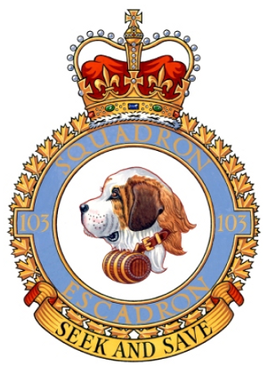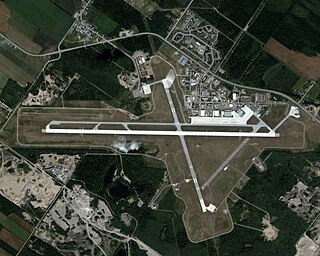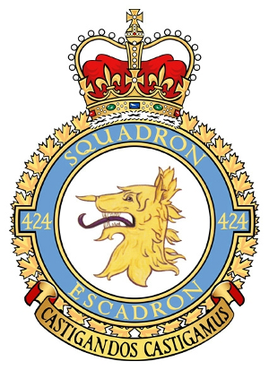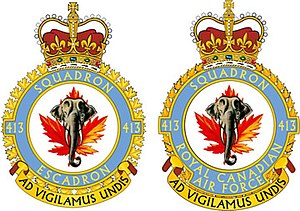The history of the Royal Canadian Air Force begins in 1914, with the formation of the Canadian Aviation Corps (CAC) that was attached to the Canadian Expeditionary Force during the First World War. It consisted of one aircraft that was never called into service. In 1918, a wing of two Canadian squadrons called the Canadian Air Force (CAF) was formed in England and attached to the Royal Air Force, but it also would never see wartime service. Postwar, an air militia also known as the Canadian Air Force was formed in Canada in 1920. In 1924 the CAF was renamed the Royal Canadian Air Force (RCAF) when it was granted the royal title by King George V. The RCAF existed as an independent service until 1968.
Canadian Forces Base Summerside was an air force base located in St. Eleanors, Prince Edward Island, Canada, now part of the city of Summerside.

A Canadian Forces base or CFB is a military installation of the Canadian Armed Forces. For a facility to qualify as a Canadian Forces base, it must station one or more major units.

The Royal Canadian Air Force is the air and space force of Canada. Its role is to "provide the Canadian Forces with relevant, responsive and effective airpower". The RCAF is one of three environmental commands within the unified Canadian Armed Forces. As of 2020, the Royal Canadian Air Force consists of 12,074 Regular Force and 1,969 Primary Reserve personnel, supported by 1,518 civilians, and operates 258 manned aircraft and nine unmanned aerial vehicles. Lieutenant-General Eric Kenny is the current commander of the Royal Canadian Air Force and chief of the Air Force Staff.

Canadian Forces Base Greenwood, or CFB Greenwood, is a Canadian Forces Base located 1.5 nautical miles east of Greenwood, Nova Scotia. It is primarily operated as an air force base by the Royal Canadian Air Force and is one of two bases in the country using the CP-140 Aurora and CP-140A Arcturus anti-submarine/maritime patrol and surveillance aircraft. Its primary RCAF lodger unit is 14 Wing, commonly referred to as 14 Wing Greenwood.

438 "City of Montreal" Tactical Helicopter Squadron is a unit of the Royal Canadian Air Force. The squadron operates the Bell CH-146 Griffon tactical helicopter from the Hartland de Montarville Molson Hangar of CFB St. Hubert in Quebec, Canada. Its tasks include armed and unarmed tactical utility transport, training aircrew personnel in basic and advanced aviation tactics, technical training of groundcrew personnel and flight engineers and the periodic maintenance of CH-146 fleet aircraft. They also include as residual capabilities search and rescue, reconnaissance and support to federal, provincial and local law enforcement agencies. A "total force" unit composed of members of the Regular Force, and both full time and part time reservists, the squadron is part of 1 Wing at CFB Kingston Ontario.

Canadian Forces Base Comox, commonly referred to as CFB Comox or 19 Wing, is a Canadian Forces Base located 2.5 nautical miles north northeast of Comox, Vancouver Island, British Columbia. It is primarily operated as an air force base by the Royal Canadian Air Force (RCAF) and is one of two bases in the country using the CP-140 Aurora anti-submarine/maritime patrol and surveillance aircraft. Its primary RCAF lodger unit is 19 Wing, commonly referred to as 19 Wing Comox.

Canadian Forces Base Trenton, formerly RCAF Station Trenton, is a Canadian Forces base located within the city of Quinte West, Ontario. It is operated as an air force base by the Royal Canadian Air Force (RCAF) and is the hub for air transport operations in Canada and abroad. Its primary RCAF lodger unit is 8 Wing, commonly referred to as 8 Wing Trenton. CFB Trenton is Canada's largest Air Force base and most southerly air base.

103 Search and Rescue Squadron of the Royal Canadian Air Force is a search and rescue unit based at 9 Wing Gander on the Canadian island of Newfoundland. The squadron is responsible for a large area covering the offshore waters of Canada's Exclusive Economic Zone in the Atlantic Ocean and inland areas in the Maritimes, Newfoundland and Labrador, and parts of Eastern Quebec. The squadron operates three AgustaWestland CH-149 Cormorant helicopters.

Canadian Forces Base Bagotville, commonly referred to as CFB Bagotville, and also known as Bagotville Airport or Saguenay-Bagotville Airport, is a Canadian Forces base located 4.5 nautical miles west of Bagotville in the city of Saguenay. Located in the centre of Quebec, less than 200 km (120 mi) north of Quebec City, CFB Bagotville is operated as an air force base by the Royal Canadian Air Force (RCAF) and is one of two bases in the country using the CF-18 Hornet fighter/interceptor, the other being CFB Cold Lake. Its primary RCAF lodger units are 2 Wing and 3 Wing.

Canadian Forces Base Gander, is a Canadian Forces base located in Gander, Newfoundland and Labrador. It is operated as an air force base by the Royal Canadian Air Force and is home to search and rescue operations that cover a vast swath of the western North Atlantic and southern Arctic and a Canadian Coastal Radar station amongst other things. It is home to 9 Wing Gander.

406 "City of Saskatoon" Maritime Operational Training Squadron is a Royal Canadian Air Force (RCAF) unit of the Canadian Armed Forces. Based at 12 Wing Shearwater since 1972, it is responsible for crew training on the Sikorsky CH-148 Cyclone since summer of 2016. The squadron was formed during World War II as part of RAF Fighter Command.

442 Transport and Rescue Squadron is a Royal Canadian Air Force tactical transport and search and rescue unit based at Canadian Forces Base (CFB) Comox in British Columbia. The squadron flies six CC-295 Kingfisher aircraft, replacing six CC-115 Buffalo STOL aircraft, which have been retired as of 2020, and five AgustaWestland CH-149 Cormorant rescue helicopters. One of each is on constant readiness to deploy in response to distress calls in the Victoria Search and Rescue Region, which includes most of British Columbia and the territory of Yukon as well as 560,000 square kilometres in the Pacific Ocean, up to 600 nautical miles (1,100 km) offshore. The squadron also serves as the operational training unit for the CH-149 Cormorant helicopter and CC-295 Kingfisher aircraft.
Air Transport Command (ATC) was a command of the Canadian Forces created in 1968 upon unification and eliminated in 1975.

Canadian Armed Forces Search and Rescue is the collective name used to refer to search and rescue (SAR) resources and operations within the Canadian Armed Forces (CAF). The Royal Canadian Navy (RCN) and Royal Canadian Air Force (RCAF) are jointly responsible for Canada’s SAR operations.

424 Transport and Rescue Squadron, nicknamed "Tiger Squadron", is a Royal Canadian Air Force strategic transport and search and rescue unit based at Canadian Forces Base (CFB) Trenton in the Canadian province of Ontario. The squadron is the primary provider of search and rescue response for the Trenton Search and Rescue Region, which extends from Quebec City to the Rocky Mountains, and from the Canada–United States border to the North Pole, covering an area of over ten million square kilometres in Central, Western, and Northern Canada.

440 Transport Squadron is a unit of the Canadian Armed Forces under the Royal Canadian Air Force. It is part of 8 Wing and works closely with Joint Task Force (North) in Yellowknife, Northwest Territories.

The Joint Rescue Coordination Centre Halifax is a rescue coordination centre operated by the Royal Canadian Air Force (RCAF) and the Canadian Coast Guard (CCG).
The Joint Rescue Coordination Centre Trenton is a rescue coordination centre operated by the Royal Canadian Air Force (RCAF) and the Canadian Coast Guard (CCG).
This is the structure of the Royal Canadian Air Force, as of November 2020.
















